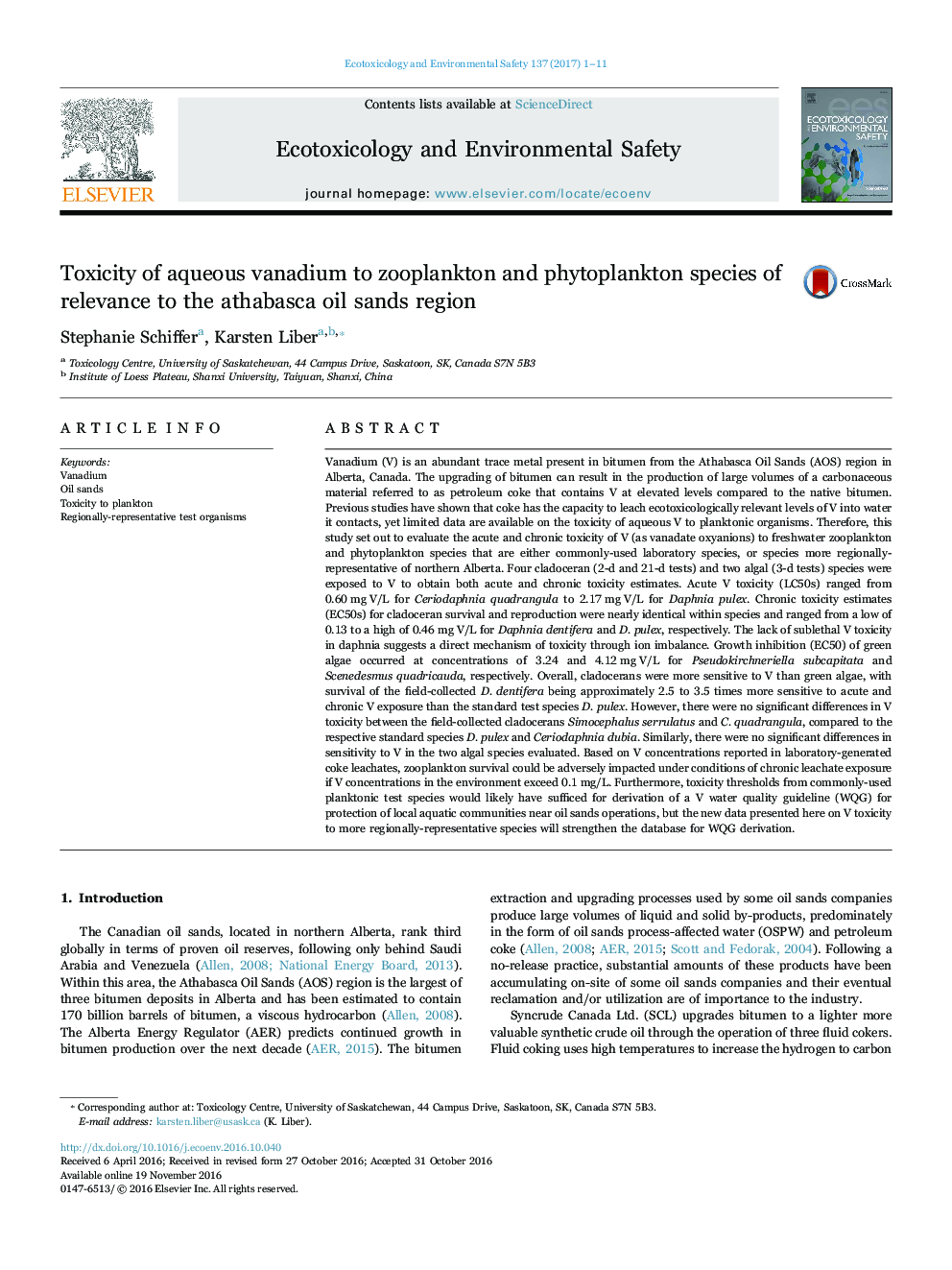| کد مقاله | کد نشریه | سال انتشار | مقاله انگلیسی | نسخه تمام متن |
|---|---|---|---|---|
| 5748045 | 1618927 | 2017 | 11 صفحه PDF | دانلود رایگان |
- Field-collected zooplankton species were more sensitive to V than conventional zooplankton species.
- Regionally-relevant and conventional phytoplankton species had similar sensitivity to V and were less sensitive than zooplankton.
- Chronic toxicity estimates for zooplankton were within range of V that could leach from oil sands petroleum coke.
- Incorporating regionally-relevant species will strengthen V water quality guideline application in northern Alberta.
Vanadium (V) is an abundant trace metal present in bitumen from the Athabasca Oil Sands (AOS) region in Alberta, Canada. The upgrading of bitumen can result in the production of large volumes of a carbonaceous material referred to as petroleum coke that contains V at elevated levels compared to the native bitumen. Previous studies have shown that coke has the capacity to leach ecotoxicologically relevant levels of V into water it contacts, yet limited data are available on the toxicity of aqueous V to planktonic organisms. Therefore, this study set out to evaluate the acute and chronic toxicity of V (as vanadate oxyanions) to freshwater zooplankton and phytoplankton species that are either commonly-used laboratory species, or species more regionally-representative of northern Alberta. Four cladoceran (2-d and 21-d tests) and two algal (3-d tests) species were exposed to V to obtain both acute and chronic toxicity estimates. Acute V toxicity (LC50s) ranged from 0.60 mg V/L for Ceriodaphnia quadrangula to 2.17 mg V/L for Daphnia pulex. Chronic toxicity estimates (EC50s) for cladoceran survival and reproduction were nearly identical within species and ranged from a low of 0.13 to a high of 0.46 mg V/L for Daphnia dentifera and D. pulex, respectively. The lack of sublethal V toxicity in daphnia suggests a direct mechanism of toxicity through ion imbalance. Growth inhibition (EC50) of green algae occurred at concentrations of 3.24 and 4.12 mg V/L for Pseudokirchneriella subcapitata and Scenedesmus quadricauda, respectively. Overall, cladocerans were more sensitive to V than green algae, with survival of the field-collected D. dentifera being approximately 2.5 to 3.5 times more sensitive to acute and chronic V exposure than the standard test species D. pulex. However, there were no significant differences in V toxicity between the field-collected cladocerans Simocephalus serrulatus and C. quadrangula, compared to the respective standard species D. pulex and Ceriodaphnia dubia. Similarly, there were no significant differences in sensitivity to V in the two algal species evaluated. Based on V concentrations reported in laboratory-generated coke leachates, zooplankton survival could be adversely impacted under conditions of chronic leachate exposure if V concentrations in the environment exceed 0.1 mg/L. Furthermore, toxicity thresholds from commonly-used planktonic test species would likely have sufficed for derivation of a V water quality guideline (WQG) for protection of local aquatic communities near oil sands operations, but the new data presented here on V toxicity to more regionally-representative species will strengthen the database for WQG derivation.
Journal: Ecotoxicology and Environmental Safety - Volume 137, March 2017, Pages 1-11
